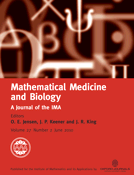-
Views
-
Cite
Cite
Martin Kroon, A constitutive model for smooth muscle including active tone and passive viscoelastic behaviour, Mathematical Medicine and Biology: A Journal of the IMA, Volume 27, Issue 2, June 2010, Pages 129–155, https://doi.org/10.1093/imammb/dqp017
Close - Share Icon Share
Abstract
A new constitutive model for the biomechanical behaviour of smooth muscle tissue is proposed. The active muscle contraction is accomplished by the relative sliding between actin and myosin filaments, comprising contractile units in the smooth muscle cells. The model includes a chemical part, governing the cross-bridge (myosin head) cycling, that is responsible for the filament sliding. The number of activated cross-bridges govern the contractile force generated and also the contraction speed. A strain-energy function is used to describe the mechanical behaviour of the smooth muscle tissue. Besides the active contractile apparatus, the mechanical model also incorporates a passive viscoelastic part. The constitutive model was calibrated with respect to experiments on smooth muscle tissue from swine carotid artery and guinea pig taenia coli, in terms of isometric and isotonic tensile test results. The model was fully able to reproduce the experimental results.





